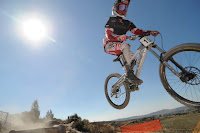My primary aim is to spend no more than 2 minutes per shot - from camera to web. The first smart thing to do of course is capture a good shot first up since no amount of post-processing can fix it - or as a journalist mate of mine says 'you can't polish turds' - eeew. This means capturing the shot as cleanly as possible - good exposure, good focus, nice composition and if possible try and weave some emotion into the shot which can mean waiting until a cyclist's expression is emotive or reflects their riding personality or which best conveys the nature of the race or event.
Having got a keeper worth posting to the web, here's what I use to make it happen:
1. Thumbsplus 7 on top of an SQL Server database for image management
2. Adobe Photoshop CS2 for complex image processing
3. Nikon Capture NX to convert Nikon RAW .NEF files
4. Adobe DNG convertor to convert .NEF to .DNG formats
5. Adobe Bridge
1. Photo management
I've used Thumbsplus since the late 90's. It's currently up to version 7 and shortly coming out as version 8. Out-of-the-box TP uses the Microsoft Jet Engine (the actual database behind Microsoft Access) to manage photo files.
 I've dispensed with the Access ('Jet') storage and instead linked TP to an SQL Server Express 2005 backend.
I've dispensed with the Access ('Jet') storage and instead linked TP to an SQL Server Express 2005 backend. The speed, indexing, security, reliability and certainty that SQL Server offers is way above what the Jet engine can do; in fact, being able to locate one image out of 100,000+ in a few milliseconds is critical when responding to online request for certain images.
Thumbsplus also has an image viewer called TPView which doubles as a very capable editor. It's especially useful for crop, rotate, contrast changes etc. If your photography is mostly for news - online or print - then TPView is probably all you need. It can't dodge, burn or repair images but that's not really necessary for the work I do.
Thumbsplus can also be configured to launch applications such as Photoshop using DDE (dynamic data exchange). It will pass selected image(s) to the called application. This reduces processing time considerably and makes TP an exceptional image manager - bit of a sleeper in fact since it doesn't get a lot of coverage compared to many other lesser systems currently in vogue.
2. Photo processing
Photoshop CS2 is my preferred application for complex image processing. If you know Photoshop then you'll understand its popularity. Allied with Bridge and the many plugins available it's a great tool. I'm sure there are many other applications that do some things better than PS CS2, but for all-round image/photo processing it does me.
3. From camera RAW to disk
Nikon Capture NX comes as a licenced application with most high-end Nikon cameras. It's a fine tool for converting .NEF format images to something that Photoshop CS2 and Thumbsplus can work with. Being a Java application it's not the fastest piece of software, but it does a commendable job converting RAW .NEFs and quite a bit of useful RAW processsing - exposure and whitebalance adjustments in particular.
Since Photoshop CS2 has now probably fallen off the upgrade path it's unlikely to ever be able to open the newer Nikon RAW .NEF files so Nikon Capture NX is essential for getting files to a format the PS CS2 can understand. I could of course convert the .NEF files to Adobe DNG (see next section) format and go that way but I reserve that extra step for scenic stuff where speed is not an issue - remember we're looking for '2 minutes tops per photo' so another step is a burden.
I should add that I hardly ever capture cycling events in RAW .NEF - the high-quality and hence large file size is not really necessary unless a particular set of circumstances make for either tricky lighting or white balance settings or where exposure is difficult or when I'm shooting something I know will probably end up in a magazine. Those shots deserve the highest quality for later processing.
4. DNG - a camera RAW to disk alternative
Adobe has pushed hard to establish a non-proprietary standard for storing digital images in a format than any application developer can read and write - a standard that then should exist far into the future. Their DNG convertor takes Nikon .NEF (and many other Camera manufacturer formats) and creates a .DNG (a 'digital negative') formatted file.
The DNG format will open in CS2 so this is an alternative to Capture NX's transformation. There's a bit of chat about which is better - Adobe's DNG convertor, or Capture NX - but I haven't tested each enough to know. If I was producing fine-art images I'd probably care but it's not a big deal for web/print news media.
5. Adobe Bridge for image management
Bridge offers image management and some processing capabilities prior to processing in Photoshop. It 'can' work as an alternative to Thumbsplus, with some extra goodies thrown in, but it is not a patch on the speed of Thumbsplus with a SQL Server backend.
I only use Bridge occasionally since it's faster for me to flick back to Thumbsplus, locate another image(s) and use Thumbsplus' DDE link to send those images to Photoshop or whatever other application link that I've set up.
--
Sports photography is like a cross between gold panning and fishing - you can catch lot's of little'uns (the dust), get the occasional goodie (the nuggets) - but in the end all the keepers get processed - as fast and clean as I can; these tools make it happen.
bfn
Greg






